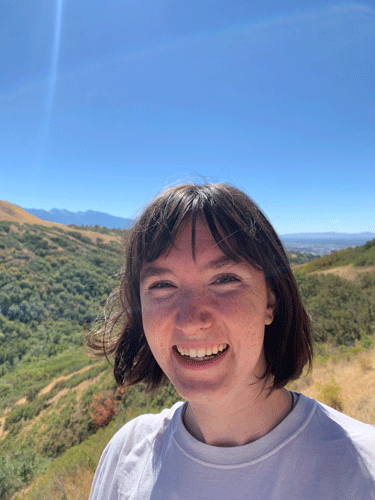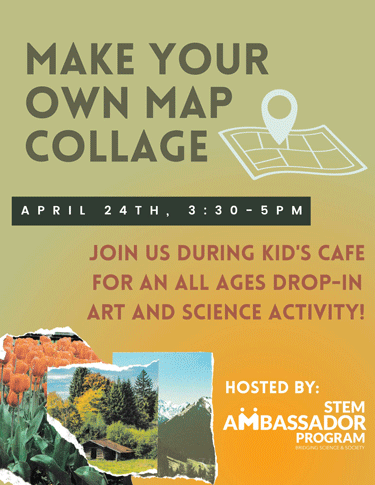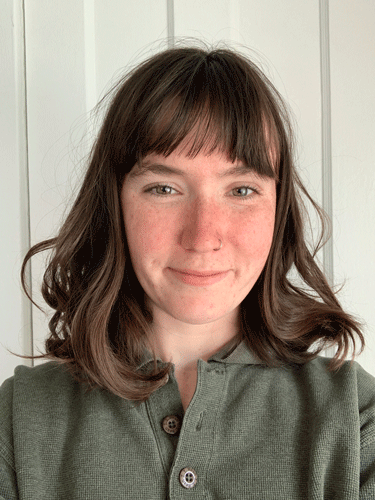Community Engagement Spotlight: Maggie Scholle

Maggie Scholle is a rising second year student from Chicago. She graduated from the University of San Diego in 2021 with a degree in environmental science. Brought home to Chicago at the onset of the pandemic, her undergraduate thesis studied potential explanations for the recession of sand at a beach local to her childhood home. Creative writing courses in undergrad also expanded her interests beyond STEM and led her to apply to the Environmental Humanities Program.
For her final project in EH, Maggie is researching Lee Kay Ponds, a conservation area and shooting range adjacent to the Salt Lake County Solid Waste Facility in northwestern Salt Lake County. Over the summer, Maggie will be conducting site visits and interviews with visitors to the area with the goal of understanding how individuals and groups situate themselves in the place and understand the area in relation to the surrounding geography and land use. As a Digital Matters Fellow for Fall '23, Maggie will work to create an ArcGIS StoryMap and other geographic visualizations showing place attachment, access, and barriers to access at Lee Kay Ponds, and will create an oral history interview repository to archive stories shared.
Maggie was a GCSC Fellow for the 2022-2023 academic year and was also part of the Spring '23 STEM Ambassador Program (STEMAP), learning tools for public engagement in the sciences. Even though Maggie's undergraduate background was in the natural sciences, she brought a unique perspective to the cohort as the only humanities graduate student. For her public engagement project, she created two activities with the Magna Library for children around place attachment. She also led two workshops with the STEM Community Alliance Program (STEMCAP) for youth-in-custody.
Below are Maggie's written responses to questions I posed about her experience doing public engagement projects with STEMAP and STEMCAP.
You were part of the Spring 2023 STEM Ambassador Program (STEMAP), which trains graduate students and faculty in public engagement. What was your experience like in STEMAP as a humanities graduate student? What public engagement project did you develop?
I had a unique role in STEMAP as a humanities student--I was a part of a cohort of 10 scientists pursuing graduate degrees in disciplines ranging from molecular biology to astrophysics. I come from a environmental science and geomorphology background, but in terms of academic interests, I was by far the least “science-y” of the group. I loved learning from everyone else in the cohort and became connected with all kinds of research on campus, just from discussing public engagement projects with my peers. We met every other week for much of the semester, and our activities during these meetings centered around explaining research without jargon, using sensory cues to spark interest in scientific processes, and how to initiate outreach to community groups in a way that serves the interest of the community.
My project uses geography as its scientific basis, but because the project is geared towards children, it focuses largely on emotional connection to place, and understanding what makes places feel inclusive and important. My thesis project is interested in place relationships at a park on the west side of Salt Lake City, and I reached out to a library branch near the park to gauge interest in hosting an open-ended STEM activity. Though my engagement project was fully unrelated to my thesis, visits to the library and the in-person activity made me feel more connected to the area.
I created two activities with STEMAP and the Magna Library. I worked with library director Melissa Wayman to create activities that were age-appropriate for the majority of youth library users (ages 5-11) and made a map collage activity and a sign-making activity, both of which have prompts for participants to reflect on their attachment to places that they care about, and reflect on how to make or keep those places inclusive.
We held an in-person event in conjunction with Kids Café, an after-school food distribution event held every weekday at the library. We also prepared a take-home version of both activities, since Melissa indicated that many patrons stop by the library for take-and-make activities. During the activity, I talked with kids about the favorite places they chose, and what those places meant to them. A lot of participants used the Oquirrh Mountains, visible outside of the library window, as a landmark on their maps, and many used the library as their favorite place to make a sign for.

In academia, public engagement and community engagement can sometimes mean different things. I’m curious if your experience in STEMAP gave you a particular definition of public engagement from the STEM fields and how that intersects with how we think about community engaged learning or community engaged research in the humanities?
My understanding is that the main difference between the public engagement I was working on and community engagement in the humanities is that I chose potential focal groups to reach out to, instead of being invited into a specific community. Our programs were designed to have a purely engagement-focused goal--there was no research intent or anything we wanted back from our partner organizations other than feedback to improve our programs. We talked a lot in the early weeks of STEMAP about the ways in which scientists have distanced themselves from communities for so long that folks often don’t think to reach out to scientists, or feel intimidated doing so, and as a scientist, doing an initial cold email after finding an organization that may be interested in STEM programming can be an effective way to re-open broken lines of communication.
We focused on co-creating programs with representatives of the organizations we worked with, so the process was reciprocal, but was initially led by the STEMAP representative. One of my favorite workshops with the cohort was a mock interview where one group member acted as a representative of an organization, and another acted as a representative of STEMAP, and we worked to create questions that would help us understand the user group and needs of the organization we were reaching out to. “Representatives” of the organization then told the STEMAP representatives what important details of their organization weren’t covered by the questions. That exercise and the research into community partners early in the program helped me ask empathetic and detailed questions to make sure that my activities would be both engaging for patrons of the library, and useful for library staff.
Another part of this process was committing to a level of work that you felt comfortable upholding, and both Melissa and I wanted to create an ongoing relationship between STEMAP and the library. I’m planning on leading these same activities again in the summer and coming back in the fall with a program adapted for older ages!
In addition to being part of STEMAP this semester, you also lead workshops for the affiliated project STEM Community Alliance Program (STEMCAP), which provides educational opportunities for Youth-In-Custody. What was the focus of each of these workshops and what was the experience like leading these workshops for this group of young people?
My interest in presenting with STEMCAP was sparked by watching David Pellow’s 2019 GCSC lecture: Towards a Critical Environmental Justice: Exploring State Violence in a Settler Colonial context. The desire for social science education in state prisons and need for justice-oriented education while we still have the carceral system we do made me admire the work Laura George is doing and reach out during a call for presenters.
The first workshop I led was on using maps to understand environmental change. I led a discussion on the Great Salt Lake and coastal processes for the first half of class, and for the second half of class, students worked on an art activity, tracing historic shorelines of the Great Salt Lake from aerial imagery. Going into the presentation, I wasn’t sure what to expect in terms of engagement, having never worked with high school aged folks before. These students were some of the most engaged young people I’ve ever met, and asked incisive questions about research, coastal processes, and me as a student.
While I enjoyed designing and leading an activity by myself, I had an even more meaningful experience designing and leading an activity with Sydney Murray. We led a presentation on environmental justice at and around the Great Salt Lake, and delivered it to two classes, ending with a collage activity where students envisioned words and images that represented environmental justice to them. We used the Union Pacific Causeway and I-15 as analogues for infrastructure projects that create distributional injustices and talked about ways to use participatory and interpersonal justice to imagine a different future. Students had firsthand experiences of environmental and procedural injustice that they shared as we talked about institutional changes that could shape such a future. I was honest about my limited embodied experience with these injustices, but I hope that I gave students language, concepts, and solidarity to understand their experiences.
What is the value of getting involved in public engagement or community engagement opportunities as a graduate student? How have these experiences shaped your final project or thesis?
Through these experiences, I’ve not only become connected with friends across disciplines that I would not have met otherwise, but I’ve begun building relationships that I hope will last through and beyond my time in EH. I’ve learned a lot about youth education, about asking the right questions and setting a good foundation for collaborative work, and the value of being honest about my background and experiences.
Laura and Andrew, who run STEMCAP and STEMAP, are both fantastic people (and siblings!) working in really interesting fields that I didn’t know existed at the beginning of this semester. If I don’t pursue a career in academia, I’m thinking about working in community engagement with an organization like STEMCAP or STEMAP.
STEMCAP especially has given me a better understanding of systems of incarceration in Utah, and I’ve learned that some cleanup at my thesis site has been done by incarcerated folks at the county prison. I’m working now on digging more into that history and environmental injustices faced by incarcerated people related to working arrangements and conditions near the Great Salt Lake.

Categories
Featured Posts
Tag Cloud
- community engagement (12)
- outdoor recreation (2)
- outreach (1)
- alumni (3)
- admissions (1)
- faculty (8)
- practitioner-in-residence (2)
- cultural anthropology (1)
- utah award in the environmental humanities (1)
- environmental justice (2)
- STEMCAP (2)
- STEM (2)
- water (1)
- communications (2)
- humanities (1)
- Taft-Nicholson Center (1)
- director (3)
- student (5)
- API (1)
- Asian American (1)
- Pacific Islander (1)
- graduation (1)
- research (3)
- thesis (1)
- project (1)
- Indigenous (1)
- Shoshone (1)
- Great Salt Lake (2)
- Bear River (1)
- land acknowledgement (1)
- STEMAP (1)
- public engagement (1)
- science (1)
- science communication (1)
- Wilkes Center (1)
- climate change (1)
- climate science (1)
- climate policy (1)
- policymaking (1)
- funding (1)
- storytelling (1)
- radio (1)
- journalism (1)
- racial justice (1)
- outdoor education (1)
- writing (1)
- non-fiction (1)
- energy extraction (1)
- reading (1)
- environmental education (1)
- affect theory (1)
- media (1)
- rhetoric (1)
